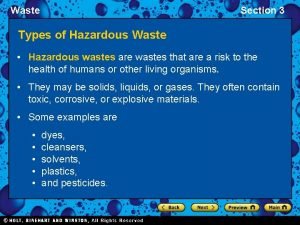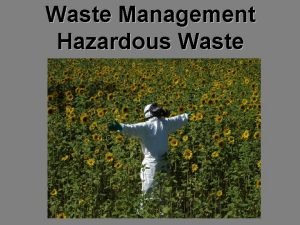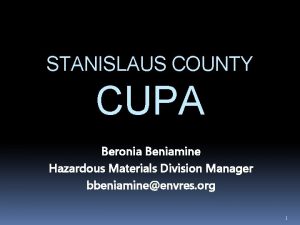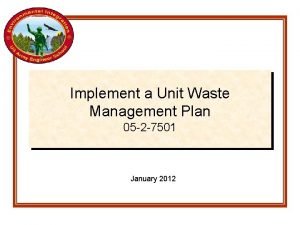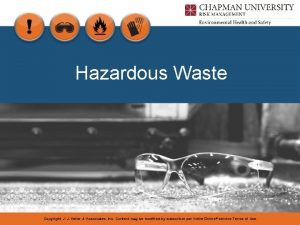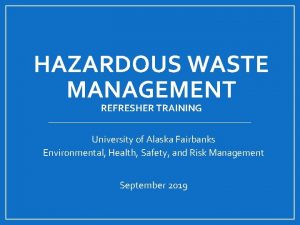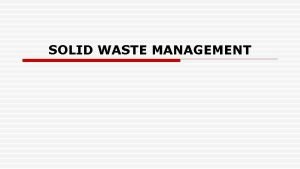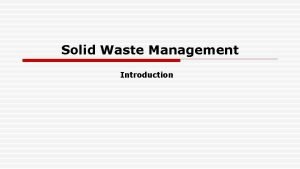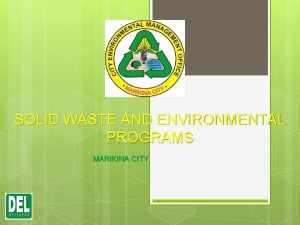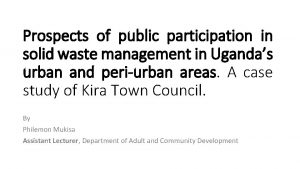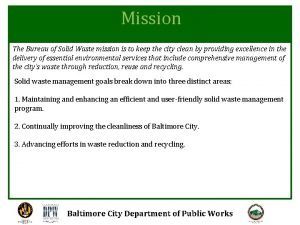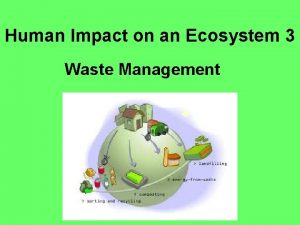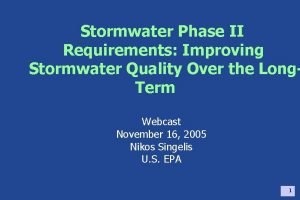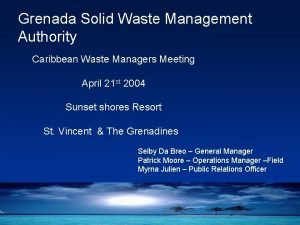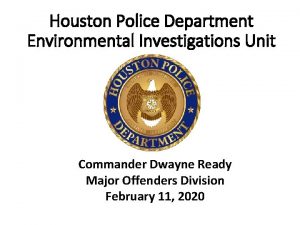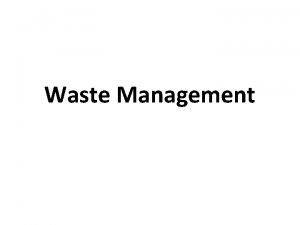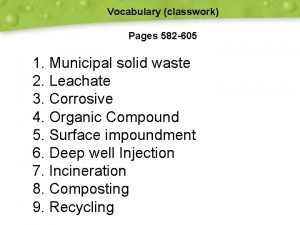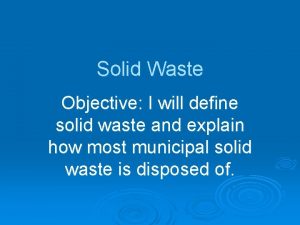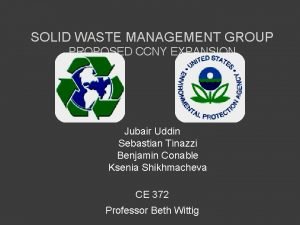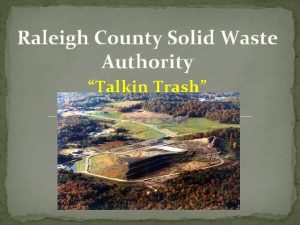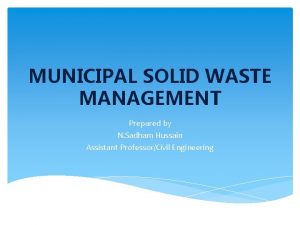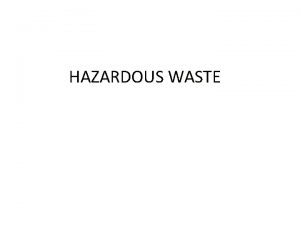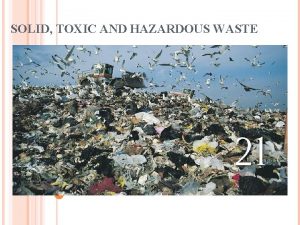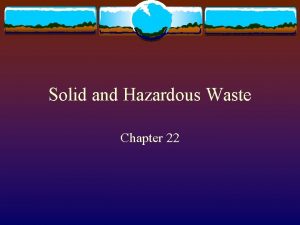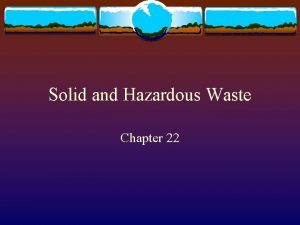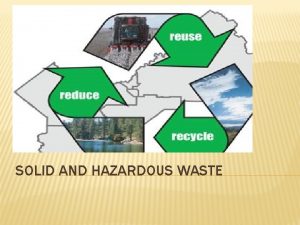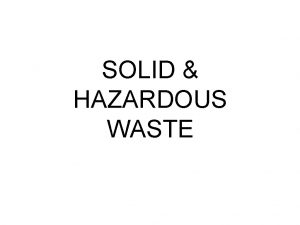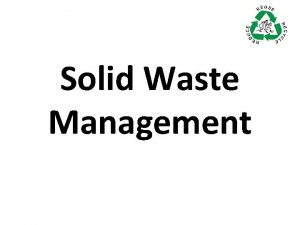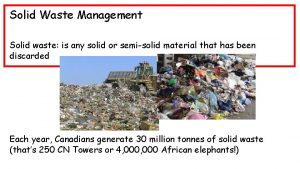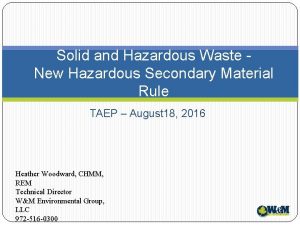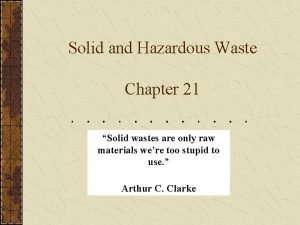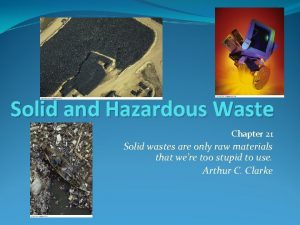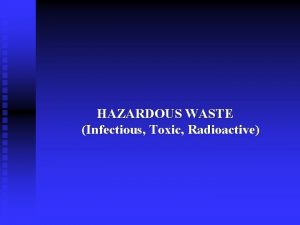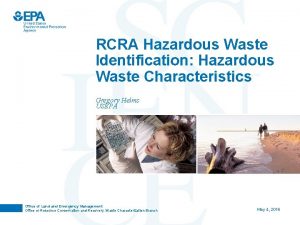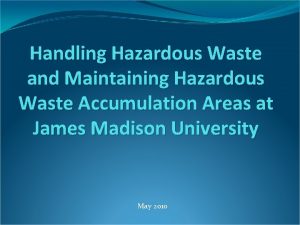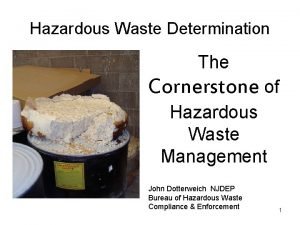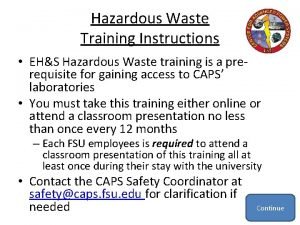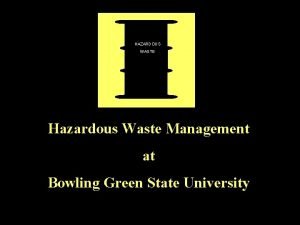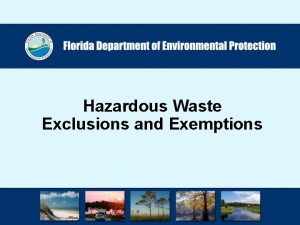Solid Hazardous Waste APES Miller Chapter 21 Where


































- Slides: 34

Solid & Hazardous Waste APES Miller - Chapter 21

Where are we going? 1. Waste in Modern Society solid waste, hazardous waste 2. Dealing with Waste options, reducing, reusing, recycling 3. Recycling types, benefits, issues 4. Managing Waste detoxifying, burning, burying, exporting 5. Achieving a Low–Waste Society

Case Study: Love Canal Ü 1971 -77 Love Canal, New York, residents began complaining of chemical smells, chemical burns on children, & many health problems; Ühousing development on old toxic waste site; Ü 1978 closed school, relocated families closest to dumps. Ü 1988 Oxy. Chem found liable; 1994 Oxy. Chem reached $98 million settlement.

1. Waste in Modern Society • solid waste: any unwanted or discarded material that is not a liquid or gas; • U. S. 4. 6% of world population, generates 33% of solid waste, 10 billion metric tons/year Sources of solid waste

Municipal Solid Waste • in U. S. , 680 (1, 500 pounds) kilograms/person/year; • 54% dumped in landfills; • 16% burned in incinerators & waste–to–energy plants; • 30% recycled or composted.

Hazardous Waste Definition in U. S. : • toxic: contains one or more of 39 toxic, carcinogenic, or mutagenic, compounds that exceed established limits; • flammable: (gasoline, paints, solvents. . . ) • reactive/unstable: can explode or release toxic fumes (acids, bases, chlorine bleach).

Hazardous Waste does NOT include: • many important omissions: radioactive wastes, hazardous & toxic wastes discarded by households, mining wastes, oil & gas drilling wastes, liquid waste containing organic compounds, cement kiln dust, wastes from small businesses & industries; • Hence hazard waste laws do NOT regulate 95% of the country’s hazard waste. • environmentalists call this: "linguistic detoxification"

2. Dealing With Waste • waste management (a high waste approach) “waste is an unavoidable product of economic growth, lets bury it or burn it” • waste prevention (a low waste approaches) “there is no away, hence: ” 1) reduce, 2) reuse, 3) recycle & compost, 4) chemically & biologically treat 5) bury

Dealing with Solid Waste Priorities suggested for dealing with material use and solid waste p a t e i l p e h t n i d S U o N Fig 21 -3

Dealing with Hazardous Waste Fig 21 -4 o N p a t e i l p i d h t n S U e

Green Design Refer to p. 398 -399 in Miller minimizes environmental impact by efficient use of energy & materials.

How can We Reduce Waste & Pollution • decrease consumption; do you really need that, secondhand? • redesign manufacturing processes to produce less waste; toxic waste can be recycled within plants, or replaced with water-based solvents • produce durable goods that can be repaired or maintained; i. e. soda and beer bottles, rebuild car parts • eliminate unnecessary packaging; “sell the product not the wrapping” • institute "trash taxes" by charging for unnecessary waste. “Pay-as-you-throw”

Reuse extends resource supplies, prevent pollution. • refillable containers - developing countries shifting to non– refillable containers; - various developed countries returning to refillable containers (e. g. , Denmark banned non–refillable containers, Finland 95% refillable, Germany 73% refillable); - various states in U. S. require deposits

Reuse • tires: retreads, construction, artificial reefs. • paper or plastic? - plastic bags need less energy than paper bags, but degrade slowly & use non– renewable resources; So bring your own bag

3. Recycling various kinds of reuse of resources • composting organic materials are broken down by microorganisms to produce a humuslike material used to condition soils; • primary (closed loop): reusing waste materials to produce materials of the same type (e. g. , newspaper to make newspaper, aluminum cans); • secondary (open loop): using waste materials to produce different products (e. g. , glass bottles to produce aggregate for roads).

Generalized material-recovery Fig 21 -8

Aluminum • recycled aluminum produces 95% less air pollution, uses 97% less water, & requires 95% less energy than mining & processing aluminum ore; • market price high because of high costs of mining & processing raw ore; • many environmentalists view aluminum cans as undesirable refillable glass or plastic bottles more energy–efficient & less polluting.

Wastepaper • easy to recycle, good market, & significant consumer demand; • recycling postconsumer waste prevents disposal by incineration or land fills; • recycling preconsumer waste (scraps & cuttings from paper & printing plants) has always been done, & is therefore just a marketing ploy.

Recycling Sunday Newspaper • uses 30– 64% less energy • reduces air pollution by pulp mills 74– 95% • lowers water pollution by 35% • prevents groundwater contamination by toxic ink leaching from landfills • conserves large amounts of water • saves landfill space • creates five times more jobs • saves money.

Plastics • must be sorted by type (according to resin); • current price of virgin plastic resins is about 40% lower than recycled resins (low oil price); • PET, used for plastic beverage bottles, prices competitive; • often used in secondary recycling, e. g. , construction materials & plastic bags made from beverage bottles.

4. Managing Waste • Detoxification: i. e. microorganisms & enzymes can break down some toxic materials, plants can take up toxic materials from the soil. • Incineration: - reduces overall quantity; but causes air pollution i. e. dioxins (chlorinated hydrocarbons), mercury & lead;

Waste-to-Energy Incineration Similar to Fig 21 -10

Landfills land disposal - burial or impoundment; - sanitary land fill stores solid wastes in compacted layers that are covered daily with layers of clay or plastic foam; - most U. S. hazardous waste disposed by deep– well injections, surface impoundment, & state –of–the–art landfills;

State-of-the-art sanitary landfill, minimize environmental contaminations Fig 21 -12 KNOW!!

Underground Storage

Long–Term Impoundment Fig 21 -17

Hazardous Waste Regulation Two major U. S. laws: • Resource Conservation & Recovery Act (RCRA) • requires EPA to identify hazardous wastes & set standards; - requires permits for firms that produce more than 100 kilograms (220 pounds); - "cradle to grave" to keep track of waste transferred from point of origin to approved disposal facilities.

Hazardous Waste Regulation Superfund Act (1990) • Environmental Response, Compensation & Liability Act - established $16. 3 billion Superfund to identify & clean up abandoned hazardous waste dump sites such as Love Canal; - cleanup based on "polluter pays principle“, hence, no tax money is used; - currently 1, 360 sites on National Priority List.

Case Study: Lead • acute lead poisoning causes severe neurological problems; children who survive acute lead poisoning can display decline in mental capabilities, paralysis, blindness, & mental retardation; • chronic lead poisoning results because of bioaccumulation; especially threat to children; • exposure in U. S. decreased due to regulation that phased out lead in gasoline & solder; • other sources include old paint, plumbing, & ceramic glazes, air pollution from incineration.

Case Study: Lead Fig 21 -18

Case Study: Dioxins • family of 75 chlorinated hydrocarbons formed as unwanted by–products in many manufacturing processes; • promote cancer, cause reproductive problems, & weaken immune system; • sources: medical waste incinerators, paper mills, iron ore sintering plants, & cement kilns used to burn hazardous wastes.

Case Study: Chlorine Cl • chlorine used to produce plastics, kilns, paper & wood pulp, purify water, & produce household bleaching agents; • many chlorine containing compounds are persistent, bioaccumulate in body fat, & cause serious health problems; • less harmful & affordable alternatives (e. g. , ozone to purify water).

5. Achieving a Low–Waste Society • reducing, reusing, & recycling ("the three R's") most effective means, in that order; • consumer choice of quality "green" products, that last a long time, have minimal environmental impacts during manufacture, & have parts that can be reused or recycled; • low–waste practices "built into the system" by redesigning manufacturing processes & refocusing research & development efforts; • grassroots efforts to support environmentally sound practices for incinerators, landfills, & treatment plants for hazardous & radioactive wastes.

"Solid wastes are only raw materials we're too stupid to use. " -- Arthur C. Clarke
 Hazardous waste apes
Hazardous waste apes Solid and hazardous waste
Solid and hazardous waste Section 3 hazardous waste answers
Section 3 hazardous waste answers Dr neha agrawal
Dr neha agrawal Example of hazardous waste
Example of hazardous waste Stanislaus county hazardous waste
Stanislaus county hazardous waste Waste management references
Waste management references Keller hazardous waste disposal
Keller hazardous waste disposal Rcra hazardous waste refresher
Rcra hazardous waste refresher 2d miller indices
2d miller indices Daniel miller arthur miller
Daniel miller arthur miller Medical plaza miller 131 miller street
Medical plaza miller 131 miller street Introduction to waste management
Introduction to waste management Solid
Solid Define solid waste management
Define solid waste management Marikina city solid waste management
Marikina city solid waste management Solid waste disposal introduction
Solid waste disposal introduction Waste management conclusion
Waste management conclusion 3 waste disposal
3 waste disposal Types of transfer stations in solid waste management
Types of transfer stations in solid waste management Rockwood solid waste
Rockwood solid waste Solid waste management
Solid waste management Trash service grenada
Trash service grenada Chemical composition of solid waste
Chemical composition of solid waste Nakasaad sa batas ra 9147
Nakasaad sa batas ra 9147 How to reduce solid waste
How to reduce solid waste Material balance analysis solid waste
Material balance analysis solid waste Solid waste management
Solid waste management Liquid wastes examples
Liquid wastes examples 582 605
582 605 Define solid waste
Define solid waste Solid waste management objectives
Solid waste management objectives Effects of solid waste
Effects of solid waste Raleigh county landfill
Raleigh county landfill What is allied health professionals
What is allied health professionals


